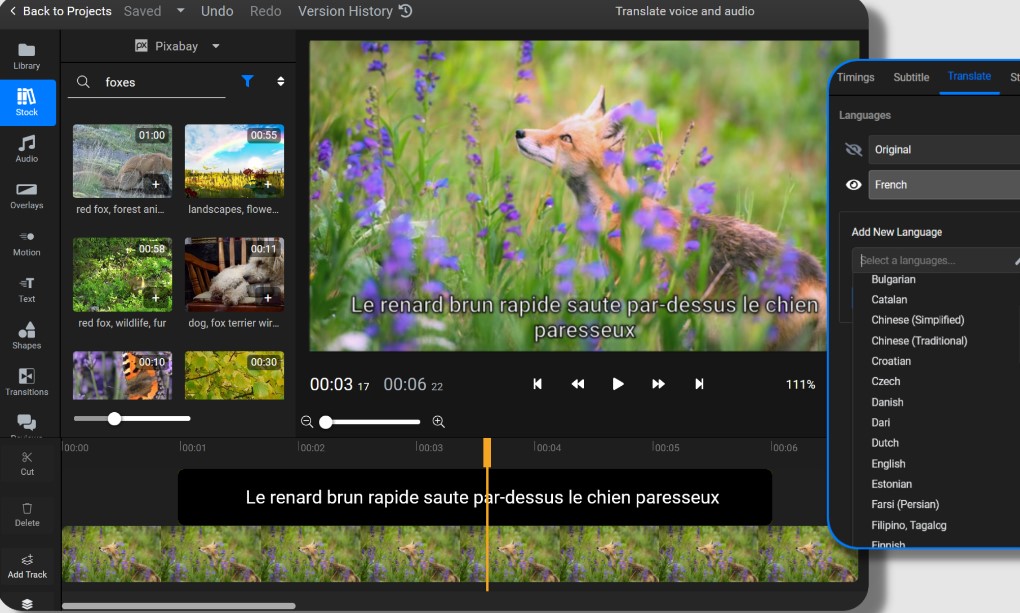Voice Translator Online: Best Tools for Accurate Translations
In an increasingly globalized world, communication between people speaking different languages has become essential. Whether it’s for business, travel, or personal reasons, language barriers can often pose challenges that hinder effective communication. The development of voice translator online tools has revolutionized the way we approach language translation. These tools offer real-time, spoken translations, allowing users to communicate effortlessly with others, no matter what language they speak.
Voice translator online tools have emerged as invaluable solutions for bridging the gap between different languages, allowing anyone with an internet connection to communicate across language barriers. In this article, we’ll explore what a voice translator online is, how it works, its advantages, and the best tools available on the market today. Additionally, we will cover detailed information about some of the top tools, including their features, pricing, and use cases, to help you make an informed decision.
What is a Voice Translator Online?

A voice translator online is a digital tool or application that translates spoken words from one language into another in real-time. These tools leverage advanced voice recognition technology combined with machine learning algorithms to accurately convert speech into text and translate it into a different language. Voice translation is a significant step up from traditional text translation tools because it offers the convenience of instant translation without requiring manual typing or input.
Voice translator tools are available on both web platforms and mobile apps, making them versatile and accessible from almost any device, whether you’re on your computer, tablet, or smartphone. Some tools even integrate with smart devices like smart speakers and wearables, enabling hands-free operation.
These tools typically support multiple languages, and many include additional features such as text-to-speech conversion, voice output in the translated language, and even offline translation capabilities. These features make them incredibly useful for individuals who travel, work in international environments, or need to communicate with people speaking different languages.
Advantages of Using a Voice Translator Online
Convenience and Speed
One of the primary advantages of using a voice translator online is the convenience it offers. Traditional language translation methods, such as looking up words in a dictionary or writing down phrases to translate later, are time-consuming and inefficient. With a voice translator, you can speak directly into the app or device, and receive a translation within seconds. This immediate translation capability ensures that you don’t waste time, whether you’re in a meeting, navigating a foreign city, or conversing with someone who speaks a different language.
For people traveling abroad, voice translator tools are invaluable. When you need directions, want to order food, or have a conversation with someone who doesn’t speak your language, these tools make the process much faster and more efficient than ever before.
Accuracy and Precision
Voice translator online services have significantly improved in terms of accuracy and precision. Many of these tools use machine learning algorithms and artificial intelligence (AI) to improve their translations over time, learning from previous data to refine their understanding of different languages. As a result, these tools can provide highly accurate translations for even complex phrases, idioms, and technical language.
Modern voice translation tools are capable of detecting various accents, regional dialects, and pronunciation nuances. This is especially useful in real-world situations, where people may speak with different accents or use informal language that might not always be found in a standard dictionary.
However, while these tools are incredibly accurate, there are still some limitations. For instance, complex or highly technical phrases, slang, and cultural nuances may not always be perfectly captured. Despite these challenges, the technology is continually improving, and for everyday conversations, the translations are often more than sufficient.
Multi-Language Support
Another key advantage of voice translator online services is their ability to support a wide range of languages. Most modern translation tools support over 50 languages, and some even cover hundreds of languages. This makes voice translation tools incredibly versatile and applicable in a wide range of contexts.
Whether you’re traveling in a popular tourist destination like Europe or Asia or working with a business partner in a less commonly spoken language, you’ll likely find that many online translators can help you communicate effectively. Multi-language support ensures that individuals from all corners of the globe can access these tools and communicate freely, regardless of the language they speak.
Enhanced User Experience
Most voice translator online tools are designed with a focus on user experience. Many offer simple, intuitive interfaces that make them easy to use, even for people who are not very tech-savvy. For instance, some apps allow users to simply speak into the microphone of their device, and the tool will automatically detect the language being spoken, translate it, and read the translated text back to the user.
Additional features, such as saving past translations, listening to spoken translations, and offline translation capabilities, make the experience even more seamless. Some tools even allow users to download language packs for offline use, which is especially useful in situations where you don’t have internet access but still need to communicate in a different language.
Types of Voice Translator Online

Voice translator online tools come in various forms, each designed to meet different needs and preferences. These tools have become essential for facilitating communication across language barriers, whether for business, travel, or personal use. Below, we explore the different types of voice translator online services available, including their functionalities, features, and ideal use cases.
1. Mobile Voice Translator Apps
Mobile voice translator apps are among the most popular and accessible types of voice translators available today. These apps can be downloaded on smartphones and are available for both Android and iOS devices. They are perfect for travelers, business professionals, and anyone who needs a portable translation solution.
Features:
- Voice Input: Simply speak into the microphone, and the app will translate your speech instantly.
- Multi-Language Support: Most mobile apps support dozens, if not hundreds, of languages.
- Offline Mode: Some apps allow users to download language packs for offline use, which is crucial for travel in areas with limited internet connectivity.
- Text-to-Speech: Translated text is often read aloud, which helps users with pronunciation.
Popular Examples:
- Google Translate: Free and supports over 100 languages.
- iTranslate: Offers voice translation in 40 languages with a premium version for advanced features.
2. Web-Based Voice Translator Tools
Web-based voice translator tools are designed to work directly through a browser. These platforms do not require installation and are ideal for users who prefer accessing translation services from their computers. They are commonly used by businesses and professionals who need translation assistance during work or meetings.
Features:
- Voice Recognition: Just like mobile apps, web-based tools allow users to speak directly into their computers or microphones to translate speech in real-time.
- Real-Time Translation: They often feature immediate translation with a minimal delay.
- Text and Document Translation: Some web-based tools also allow for translating entire documents and written content in addition to voice translation.
Popular Examples:
- Microsoft Translator: Free and works well for both personal and business use.
- DeepL Translator: Known for its highly accurate text translation, DeepL is expanding to voice translation services in some regions.
3. Smart Device Integrations
In addition to mobile apps and web-based platforms, voice translation is now integrated into smart devices such as smart speakers, wearables, and other AI-powered assistants. These devices offer a hands-free, always-available translation service, making them ideal for situations where manual input isn’t possible or practical.
Features:
- Voice-Activated: Users can simply speak to their device, and it will translate their speech.
- Real-Time Interaction: Instant translations during conversations without needing to pull out a phone or open an app.
- Integration with Other Services: Some smart translators work with apps like Google Assistant, Alexa, or Siri to perform translations in a seamless manner.
Popular Examples:
- Amazon Alexa with Translation Skills: Uses voice commands to translate across multiple languages.
- Google Assistant: Offers a built-in translation feature that works with voice commands.
4. Enterprise Voice Translation Software
For larger businesses or enterprises that require specialized and consistent translation, enterprise-level voice translation software is often used. These tools are designed to provide accurate translations across multiple languages in real-time for meetings, conferences, or international communication.
Features:
- Multi-Person Support: Enterprise software often supports group translations, making it ideal for multilingual business meetings or conferences.
- Customization: These tools allow for the inclusion of specialized vocabulary, often related to specific industries like legal, medical, or technical fields.
- Security: These services are usually more secure, catering to businesses that require confidentiality and data protection.
Popular Examples:
- Skype Translator: Provides voice and text translations during Skype calls.
- KUDO: A cloud-based platform for multilingual video conferencing with real-time translation capabilities.
Top Voice Translator Online Tools

Now that we’ve discussed the benefits of using a voice translator online, let’s take a look at three of the top tools available today. These tools are widely recognized for their high-quality translations, user-friendly interfaces, and feature-rich platforms.
1. Google Translate
Google Translate is arguably the most popular and widely used translation tool available today. It supports over 100 languages, which makes it one of the most comprehensive tools for anyone needing real-time translation. Whether you’re traveling, working, or learning a new language, Google Translate has the ability to translate both text and spoken words quickly and accurately.
Features
- Voice Input: You can speak directly into the app for immediate translation, making it ideal for use while traveling or in conversations with non-native speakers.
- Offline Mode: Google Translate allows you to download language packs, which is particularly useful when traveling to places with limited internet access.
- Text and Image Translation: Beyond voice translations, Google Translate can translate typed text and even text in images, which can be extremely helpful when translating signs, menus, and documents.
- Speech Output: Translations are spoken aloud, allowing you to hear the pronunciation of words and phrases in the translated language.
Pros
- Free to use.
- Offers translations in over 100 languages.
- Convenient and easy-to-use interface.
- Supports both voice and text translations.
Cons
- Occasionally inaccurate with complex phrases or idioms.
- Not always perfect with regional accents or dialects.
Pricing
Google Translate is completely free to use, making it an excellent option for anyone looking for a reliable voice translation tool without any costs involved.
2. iTranslate
iTranslate is another leading voice translation tool that is popular among travelers and professionals alike. With support for over 40 languages, iTranslate offers both text and voice translations in a user-friendly interface.
Features
- Voice Translation: iTranslate supports voice translation in multiple languages, making it a great tool for conversations and on-the-go translations.
- Offline Mode: Like Google Translate, iTranslate allows you to download language packs for offline use.
- Dictionary and Thesaurus: The app features a built-in dictionary and thesaurus to help users understand the meaning of words in context.
- Voice Output: The app can also speak the translated text aloud, helping users with pronunciation.
Pros
- High-quality translations with a focus on ease of use.
- Offline support for traveling without internet access.
- Built-in dictionary and thesaurus for a deeper understanding of words.
Cons
- The free version has limited features.
- Premium version requires a subscription.
Pricing
iTranslate offers both a free version and a premium version. The premium subscription costs $4.99/month or $39.99/year, and includes additional features such as offline translation and access to more languages.
3. Microsoft Translator
Microsoft Translator is another robust voice translation tool that integrates seamlessly with Microsoft’s suite of products. It supports over 60 languages and is designed to be used in both personal and business contexts.
Features
- Voice Translation: Microsoft Translator provides real-time voice translation, allowing users to speak directly into the app for immediate translations.
- Conversation Mode: This feature allows multiple people to speak different languages and converse using the app’s voice translation capabilities.
- Offline Mode: Users can download languages for offline translation, making it ideal for travel and business meetings in areas without reliable internet access.
Pros
- Great for group conversations with multiple languages.
- Free to use, making it accessible to a wide audience.
- Easy integration with other Microsoft tools, such as Office and Teams.
Cons
- Limited customization options for advanced users.
- Requires a Microsoft account for full access.
Pricing
Microsoft Translator is free to use for most features, but premium functionalities may be available through a Microsoft 365 subscription.
Use Cases and Problem-Solving
Voice translator online tools solve a wide variety of problems related to language barriers. Below are some key use cases:
- Traveling Abroad: Whether you’re navigating a new city, ordering food at a restaurant, or asking for directions, a voice translator makes communication easier and faster. It helps break down language barriers, ensuring that you can enjoy your trip without stress.
- Business Communication: In international business, clear communication is vital. Voice translators are essential tools in meetings, negotiations, and presentations, allowing teams to collaborate effectively without the need for a professional interpreter.
- Education: Students learning a new language or studying abroad can benefit from voice translators. They can help students understand lectures, converse with peers, and complete assignments in different languages.
- Healthcare: In medical settings, voice translation tools can assist doctors, nurses, and patients in communicating, particularly when language barriers exist in emergency situations or routine care.
How to Buy and Where to Buy
Voice translator online tools can typically be accessed for free or purchased directly from their respective websites or app stores. You can download apps like Google Translate, iTranslate, and Microsoft Translator from the Google Play Store or Apple App Store.
- Google Translate: Free to use, available via web or app.
- iTranslate: Free version available, premium subscription costs $4.99/month or $39.99/year.
- Microsoft Translator: Free for most features, available for download from the Microsoft website.
FAQs
1. Can voice translator online tools handle all languages?
Most voice translator tools support a wide range of languages, but there may be limitations for less common dialects or regional languages. Always check the language availability before relying on the tool for translation.
2. Are voice translator tools accurate for business use?
Voice translation tools are increasingly accurate, but for complex business meetings or technical language, human interpreters may still be necessary for precise communication.
3. How much do voice translator online tools cost?
Many voice translator tools, including Google Translate and Microsoft Translator, are free to use. Some tools, like iTranslate, offer both free and premium versions, with pricing starting at $4.99/month for additional features.